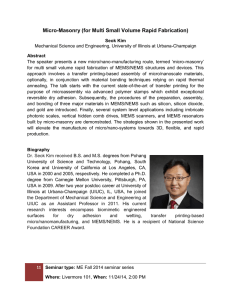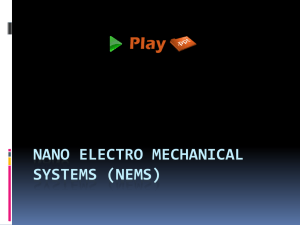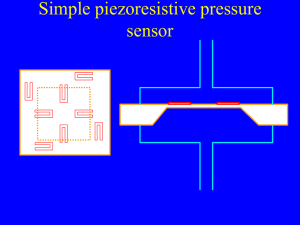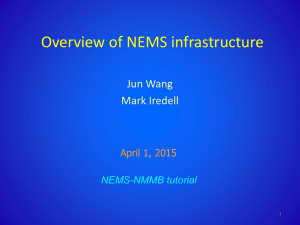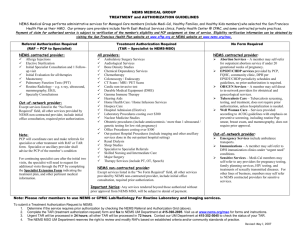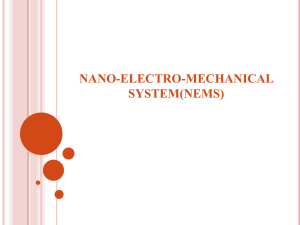Nanoelectromechanical systems face the future Physics World physicsworldarchive.iop.org Michael Roukes
advertisement
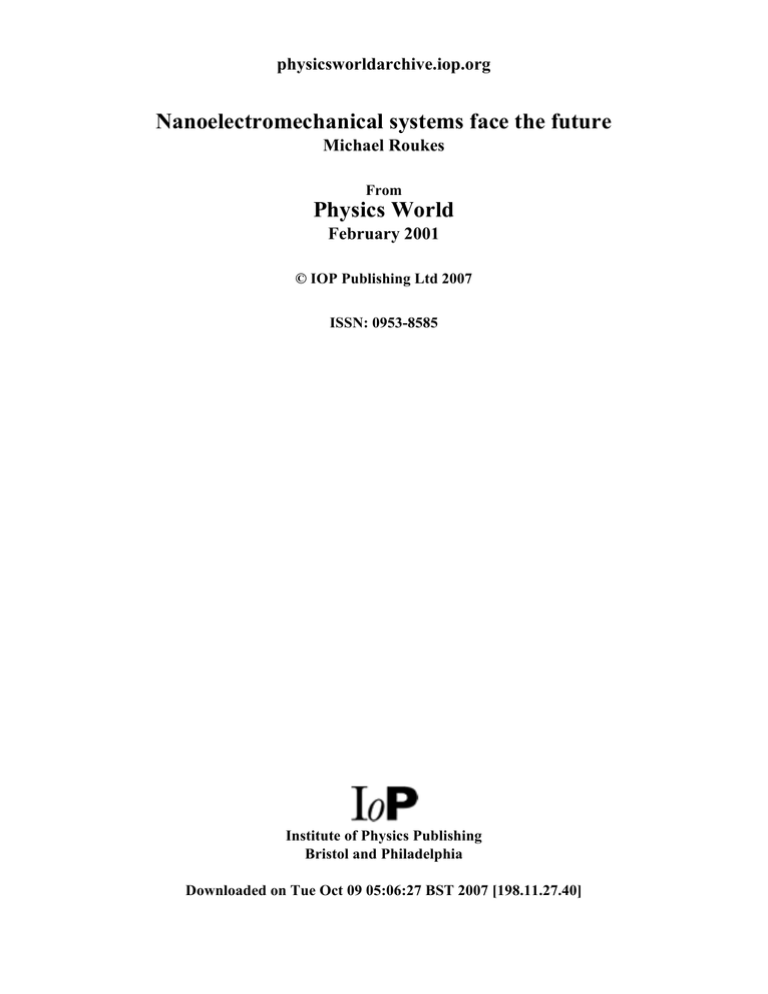
physicsworldarchive.iop.org
Nanoelectromechanical systems face the future
Michael Roukes
From
Physics World
February 2001
© IOP Publishing Ltd 2007
ISSN: 0953-8585
Institute of Physics Publishing
Bristol and Philadelphia
Downloaded on Tue Oct 09 05:06:27 BST 2007 [198.11.27.40]
FEATURES
A host of novel applications and new physics could be unleashed as
microelectromechanical systems shrink towards the nanoscale
Nanoelectromechanical
systems face the future
Michael Roukes
IN THE late 1950s visionary physicist 1 Feynman's challenge
Richard Feynman issued a public challenge by offering $1000 to the first
person to create an electrical motor
"smaller than 1 /64th of an inch". Much
to Feynman's consternation the young
man who met this challenge, William
McLellan, did so by investing many
tedious and painstaking hours building
the device by hand using tweezers and
a microscope (figure 1).
McLellan's motor now sits in a display
case at the California Institute of Technology and has long since ceased to spin.
Meanwhile, in the field that Feynman
hoped to incite, the wheels are turning- (a) Richard Feynman viewing the micromotor built by William McLellan (left) who won the challenge to
bothfigurativelyand literally — in many build the first motor smaller than l/64th of an inch, (b) The motor, 3.81 mm wide, photographed under f,
&
university and corporate laboratories, an optical microscope. The huge object above it is the head of a pin.
and even on industrial production lines.
Indeed, thefieldof microelectromechanical systems (MEMS), MEMS at sizes below one micrometre. This stands in striwhich became firmly established in the mid-1980s, has now king contrast to the recent developments in mainstream
matured to the point where we can be rather blase about the microelectronics where chips are now mass-produced with
mass production of diminutive motors that are hundreds of features as small as 0.18 microns. Indeed, SEMATECH a
times smaller than McLellan's original. Along the way the think-tank for a consortia of semiconductor companies in
MEMS community has developed some truly intriguing prod- the US - predicts diat the minimum feature size will shrink
ucts from digital projectors that contain millions of electric- to 70 nm by 2010.
ally driven micromirrors to microscale motion sensors that sit
In the face of these achievements, and the advances they
in cars ready to deploy airbags (figure 2).
are expected to bring to mainstream electronics, the time is
A whole new realm of interconnected microsensors and ripe for a conceited exploration of nanoelectromechanical
instruments is emerging from the minds and laboratories of systems (NEMS) — i.e. machines, sensors, computers and elccthe scientists and engineers engaged in this research. Their tronics that are on the nanoscale. Such efforts are under way
devices arc being assigned to a myriad of remote outposts, in my group at Caltech, and in several others around the
from the depths of the sea and the Earth's crust, to the far- world. The potential payoffs are likely to be enormous and
flung regions of space and distant planets. Moreover, the could benefit a diverse range of fields, from medicine and
robustness and low cost of such remote microsensors are biotechnology to the foundations of quantum mechanics. In
helping to provide an avalanche of information about our this article I highlight a few of the most exciting promises of
NEMS, and the challenges that must be faced to attain them.
physical surroundings.
MEMS represent the marriage of semiconductor processing to mechanical engineering - at a very small scale. And it What is an electromechanical system?
is afieldthat has grown enormously during the past decade. One of the earliest reported electromechanical devices was
Numerous companies — from the semiconductor giants to built in 1785 by Charles-Augustin de Coulomb to measure
fledgling start-ups — are all now scrambling for a piece of theelectrical charge. His electrical torsion balance consisted of
action at the microscale. Yet very little has been done with two spherical metal balls — one of which wasfixed,the other
P«Y»ict
WOULD
FEBRUARY
2001
25
MicromacWnlng now enables a huge variety of micromecnanical devices to be mass- produced, (a) A MEMS electrostatic micromotor fabricated from silicon,
(b) The Individual mechanical micromirrors at the heart of the Texas Instruments Digital Ught Processor.
attached to a moving rod — that acted as capacitor plates, con- 3). Detecting either type of response requires an output or
verting a difference in charge between them to an attractive readout transducer, which is often distinct from the input one.
force. The device illustrates the two principal components In Coulomb's case, the readout transducer was "optical" - he
common to most electi-omechanical systems irrespective of simply used his eyes to record a deflection. Today mechanical
scale: a mechanical element and transducers.
devices contain transducers that are based on a host of physThe mechanical element either deflects or vibrates in ical mechanisms involving piezoelectric and magnetomotive
response to an applied force. To measure quasi-static forces, effects, nanomagnets and electron tunnelling, as well as electhe element typically has a weak spring constant so that a trostatics and optics.
small force can deflect it by a large amount. Time-varying
forces are best measured using low-loss mechanical reson- The benefits of nanomachines
ators that have a large response to oscillating signals with Nanomechanical devices promise to revolutionize measuresmall amplitudes.
ments of extremely small displacements and extremely weak
Many different types of mechanical elements can be used forces, particularly at the molecular scale. Indeed with surto sense static or time-varying forces. These include the tor- face and bulk nanomachining techniques, NEMS can now
sion balance (used by Coulomb), the cantilever (now ubi- be built with masses approaching a few attograms (10 '8 g)
quitous in scanning probe microscopy) and the "doubly and with cross-sections of about 10 nm (figure 4). The small
clamped" beam, which is fixed at both ends. In pursuit of mass and size of NEMS gives them a number of unique
ultrahigh sensitivity, even more intricate devices are used, attributes that offer immense potential for new applications
such as compound resonant structures that possess compli- and fundamental measurements.
cated transverse, torsional or longitudinal modes of vibraMechanical systems vibrate at a natural angular frequency,
tion. These complicated modes can be used to minimize COo, that can be approximated by V\, — (^.n/wcn)l/2, where A^-is
vibrational losses, in much the same way that the handle of a an effective spring constant and mM is an effective mass.
tuning fork is positioned carefully to reduce losses.
(Underlying these simplified "effective" terms is a complex set
The transducers in MEMS and NEMS convert mechan- of elasticity equations that govern the mechanical response of
ical energy into electrical or optical signals and vice versa. these objects.) If we reduce the size of the mechanical device
However, in some cases the input transducer simply keeps the while preserving its overall shape, then the fundamental fremechanical element vibrating steadily while its characteristics quency, (OQ, increases as the linear dimension, /, decreases.
are monitored as the system is perturbed. In this case such Underlying this behaviour is the fact that the effective mass is
perturbations, rather than the input signal itself, are precisely proportional to /3, while the effective spring constant is prothe signals we wish to measure. They might include pressure portional to /. This is important because a high response frevariations that affect the mechanical damping of the device, quency translates directly to a fast response time to applied
the presence of chemical adsorbates that alter the mass of the forces. It also means that a fast response can be achieved withnanoscale resonator, or temperature changes that can modify out the expense of making stiff structures.
its elasticity or internal strain. In these last two cases, the net
Resonators with fundamental frequencies above 10 GHz
effect is to change the frequency of vibration.
(1010 Hz) can now be built using surface nanomachining
In general, the output of an electromechanical device is the processes involving state-of-the-art nanolithography at the
movement of the mechanical element. There are two main 10 nm scale (see box on page 29). Such high-frequency metypes of response: the element can simply deflect under the chanical devices are unprecedented and open up many new
applied force or its amplitude of oscillation can change (figure and exciting possibilities. Among these are ultralow-power
26
PHYSICS
WOILD
FI«RU««Y
J001
nitude less than the power consumed
mechanical signal processing at micro- 3 NEMS in action
wave frequencies and new types of fast
by conventional electronic processors
scanning probe microscopes that could
that operate by shuttling packets of
gate electrode
be used in fundamental research or
electronic charge rather than relying
perhaps even as the basis of new forms
on mechanical elements.
detection
of mechanical computers.
Another advantage of MEMS and
electrode
NEMS is that they can be fabricated
A second important attribute of
from silicon, gallium arsenide and inNEMS is that they dissipate very little
dium arsenide - the cornerstones of the
energy, a feature that is characterized
by the high quality or Q,factor of reselectronics industry - or other compatonance. As a result, NEMS are exible materials. As a result, any auxiliary
tremely sensitive to external damping
electronic components, such as transmechanisms, which is crucial for buildducers and transistors, can be fabricated
ing many types of sensors. In addition,
on the same chip as the mechanical elethe thermomechanical noise, which is
ments. Patterning NEMS so that all the
analogous to Johnson noise in electrimain internal components arc on the
cal resistors, is inversely proportional
\ same chip means that the circuits can be
to Q. High (Rvalues are therefore an
immensely complex. It also completely
important attribute for both resonant
circumvents the insurmountable proband deflection sensors, suppressing
lem of aligning different components at
random mechanical fluctuations and
the nanometre scale.
thus making these devices highly sensitive to applied forces. Indeed, this senChallenges for NEMS
sitivity appears destined to reach the
Processes such as electron-beam lithogquantum limit.
raphy and nanomachining now enable
semiconductor nanostructures to be
Typically, high-frequency electrical
fabricated below 10 nm. It would apresonators have (Rvalues less than sevpear that the technology exists to build
eral hundred, but even the first highNEMS. So what is holding up applifrequency mechanical device built in
cations? It turns out that there arc three
1994 by Andrew Cleland at Caltech
principal challenges that must be adwas 100 times better. Such high quality
dressed before the full potential of
factors arc significant for potential apNEMS can be realized: communicaplications in signal processing.
ting signals from the nanoscalc to the
The small effective mass of the vibrating part of the device - or the small (a) At the heart of the electrometer is a mechanical macroscopic world; understanding and
resonator made of silicon-on-insulator that rotates
controlling mesoscopic mechanics; and
moment of inertia for torsional devices when
a radio-frequency current is passed through
has another important consequence. the loop-shaped gold electrode in the presence of a developing methods for reproducible
It gives NEMS an astoundingly high strong magnetic field. The resulting torsional motion and routine nanofabrication.
NEMS are clearly very small devices
sensitivity to additional masses - clearly generates an electric field that is measured by the
electrode. When a charge is placed on the
that can deflect or vibrate within an
a valuable attribute for a wide range detection
gate electrode, the resulting electric field alters the
of sensing applications. Recent work frequency with which the resonator rotates, (b) First- even smaller range during operation.
For example, die deflection of a doubly
by Kamil Ekinci at Caltech supports and second-generation mechanical electrometers
clamped beam varies linearly with an
the prediction that the most sensitive built at Caltech.
applied force only if it is displaced by
devices we can currently fabricate are
measurably affected by small numbers of atoms being ad- an amount that typically corresponds to a few per cent of its
diickness. For a beam 10 nm in diameter, this translates to dissorbed on the surface of the device.
Meanwhile, the small size of NEMS also implies that they placements that are only a fraction of a nanometre. Building
have a highly localized spatial response. Moreover, the geom- transducers that are sensitive enough to allow information
etry of a NEMS device can be tailored so that the vibrating to be transferred accurately at this scale requires reading out
clement reacts only to external forces in a specific direction. positions widi a far greater precision. A further difficulty is
Thisflexibilityis extremely useful for designing new types of t_hat the natural frequency of this motion increases with decreasing size. So the ideal NEMS transducer must ultimately
scanning probe microscopes.
NEMS are also intrinsically ultralow-power devices. Their be capable of resolving displacements in the 10 ^-lO c m
fundamental power scale is defined by the thermal energy range and be able to do so up to frequencies of a few gigadivided by the response time, set by Q/(i>0. At 300 K, NEMS hertz. These two requirements are truly daunting, and much
arc only overwhelmed by thermalfluctuationswhen they are more challenging than those faced by the MEMS community
operated at the attowatt (10 18 W) level. Thus driving a so far.
NEMS device at the picowatt (10 a W) scale provides signalTo compound die problem, some of the transducers that
to-noise ratios of up to 106. Even if a million such devices are mainstays of the micromechanical realm arc not applicwere operated simultaneously in a NEMS signal processor, able in the nanoworld. Electrostatic transduction, the staple
the total power dissipated by the entire system would still only of MEMS, does not scale well into the domain of NEMS.
be about a microwatt. This is three or four orders of mag- Nanoscale electrodes have capacitances of about 10 "" farad
PHYSICS
WOILD
FEBRUARY
2001
27
and less. As a result, the many other,
unavoidable parasitic impedances tend
to dominate the "dynamic" capacitance
that is altered by the device motion.
Meanwhile optical methods, such
as simple beam-deflection schemes or
more sophisticated optical and fibreoptic interferometry- both commonly
used in scanning probe microscopy
to detect the deflection of the probe generally fail beyond the so-called diffraction limit. In other words, these
methods cannot easily be applied to
objects with cross-sections much smaller than the wavelength of light. For
fibre-optic interferometry, this breakdown can occur even earlier, when devices are shrunk to a fraction of the
diameter of the fibre.
Conventional approaches thus appear to hold little promise for high-efnciency transduction with the smallest
of NEMS devices. Nonetheless, there
are a host of intriguing new concepts in
the pipeline. These include techniques
that are based on integrated near-field
optics, nanoscale magnets, high-electron-mobility transistors, superconducting quantum interference devices and
single-electron transistors-to name just
a few. Discussion of these topics is, unfortunately, beyond the scope of this
article (see Roukes in further reading).
For example, Robert Pohl's group
at Cornell University, and others, has
shown that centimetre-scale semiconductor MEMS can have Q, factors as
high as 100 million at cryogenic temperatures. But my group at Caltech has
shown repeatedly over the past seven
years that this value decreases significantly - by a factor of between 1000
and 10 000 — as the devices are shrunk
to the nanometre scale. The reasons for
this decrease are not clear at present.
However, the greatly increased surfaceto-volume ratio in NEMS, together
with the non-optimized surface properties, is the most likely explanation.
This can be illustrated by considering
a NEMS device fabricated using stateof-the-art electron-beam lithography.
A silicon beam 100 nm long, 10 nm
wide and 10 nm thick contains only
about 5 X 105 atoms, with some 3 X 104
of these atoms residing at the surface.
In other words, more than 10% of the
constituents are surface or near-surface
atoms. It is clear that these surface
| atoms play a central role, but under| standing exactly how will take consid| erable effort. My group and others * at IBM's Almaden Research Center,
1
Stanford University, the University of
California at Santa Barbara and Cornell University, all in the US, together
with Ludwig-Maximilians University
Continued improvements in nanofabrication
in Munich, Germany - are currently
processes have led to progressively more ideal
The role of surface physics
exploring
this crucial issue (figure 5).
structures, (a) An early (and rather rough) doubly
One of the keys to realizing the poten- clamped beam "carved" from a silicon wafer, (b) A
Ultimately, as devices become ever
tial of NEMS is to achieve ultrahigh compound torsional resonator made from siliconsmaller, macroscopic mechanics will
quality factors. This overarching theme on-insulator, and (c) a "clean" example made from
break down and atomistic behaviour
underlies most areas of research, with gallium arsenide that is used to measure minute
forces at high frequencies.
will emerge. Indeed, molecular dythe possible exception of non-resonant
namics simulations, such as those perapplications. However, both intrinsic
and extrinsic properties limit the quality factor in real de- formed by Robert Rudd andJeremy Broughton at the Naval
vices. Defects in the bulk material and interfaces, fabrication- Research Laboratory in Washington DC on idealized strucinduced surface damage and adsorbates on the surfaces are tures just a few tens of atoms thick, would appear to support
among the intrinsic features that can dampen the motion of this idea.
a resonator.
Fortunately, many of these effects can be suppressed Towards routine manufacture at the nanoscale
through a careful choice of materials, processing and device NEMS must overcome a final important hurdle before
geometry. Extrinsic effects - such as air resistance, clamping nanoscale machines, sensors and electronics emerge from
losses at the supports and electrical losses mediated through industrial production lines. Put simply, when we combine
the transducers - can all be reduced by careful engineering. state-of-the-art processes from two disparate fields - nanoHowever, certain loss mechanisms are fundamental and ulti- lithography and MEMS micromachining — we increase the
mately limit the maximum attainable quality factors. These chances that something will go awry during manufacturing.
processes include thermoelastic damping that arises from Fortunately, sustained and careful work is beginning to solve
these problems and is revealing the way to build robust, reliinelastic losses in the material.
One aspect in particular looms large: as we shrink MEMS able NEMS. Given the remarkable success of microelectrontowards the domain of NEMS, the device physics becomes ics, it seems clear that such current troubles will ultimately
increasingly dominated by t_he surfaces. We would expect that become only of historical significance.
But there is a special class of difficulties unique to NEMS
extremely small mechanical devices made from single crystals
and ultrahigh-purity heterostructures would contain very few that cannot be so easily dismissed. NEMS can respond to
defects, so that energy losses in the bulk are suppressed and masses approaching the level of single atoms or molecules.
However, this sensitivity is a double-edged sword. On the one
high quality factors should be possible.
4 Clean lines in semiconductors
PHYSICS
WOULD
FEBRU»«Y
2001
Over the past six years, at my lab and elsewhere, new techniques
have been developed for patterning freely suspended 3-D
semiconductor structures. These techniques apply to bulk silicon,
epitaxial silicon and silicon-on-insulator heterostructures, as well as to
systems based on gallium arsenide and indium arsenide, (a) In its
simplest form, the procedure begins with a heterostructure that
contains structural (red) and sacrificial layers (blue) on a substrate
(yellow), (b) Masks on top of this substrate are patterned by a
combination of optical and electron-beam lithography, followed by a
thin-film deposition processes. The resulting mask (black) protects
the material beneath it during the next stage, (c) Unprotected material
around the mask is then etched away using a plasma process.
(d) Finally, a local chemically selective etch step removes the
sacrificial layer from specific regions to create freely suspended
nanostructures that are both thermally and mechanically isolated.
In typical devices this entire procedure might be repeated several
times and combined with various deposition processes to give
complicated mechanical nanostructures. The flexibility of the process
allows complex suspended structures with lateral dimensions down
to a few tens of nanometres to be fabricated. Moreover, complex
transducers can be incorporated for control and measurement
purposes. Epitaxial growth means that the thickness of the layers can
be controlled with atomic precision. In principle, the fabricated
devicescan bejustafewlayersthick.
molecular biology to materials science. The technique was
first demonstrated in 1992 by Dan Rugar and co-workers at
IBM's Almaden Research Center, and was later confirmed
by Chris Hammel at the Los Alamos National Lab in collaboration with my group at Caltech, and others.
Like conventional magnetic resonance, MRFM uses a
Some applications of NEMS
uniform radio-frequency field to excite the spins into resUltimately, NEMS could be used across a broad range of onance. A nanomagnet provides a magneticfieldthat varies
applications. At Caltech we have used NEMS for metrology so strongly in space that the nuclear-resonance condition is
and fundamental science, detecting charges by mechanical satisfied only widiin a small volume, which is about the size
methods and in thermal transport studies on die nanoscale of atom. This magnet also interacts with die resonant nu(sec Schwab el al. in further reading). In addition, a number of clear spins to generate a tiny "back action" force that causes
NEMS applications are being pursued that might hold im- the cantilever on which the nanomagnet is mounted to
mense technological promise.
vibrate. For a single resonant nucleus, die size of this force
In my opinion, most prominent among these is magnetic is a few attonewtons (10~B N) at die most. Nonetheless,
resonance force microscopy (MRFM). Nuclear magnetic res- Thomas Kenny's group at Stanford, in collaboration with
onance was first observed in 1946 by Edward Purcell, Felix Rugar's group at IBM, has demonstrated that such minute
Bloch and their collaborators, and is now routinely used for forces are measurable.
By scanning die tip over a surface, a 3-D map of die relative
medical imaging. The technique exploits the fact diat most
nuclei have an intrinsic magnetic moment or "spin" that can positions of resonating atoms can be created. Although Rugar
interact with an applied magnetic field. However, it takes and co-workers detected a signal from some 10B protons in
about 10 w—10' nuclei to generate a measurable signal. This their early experiments, the sensitivity still exceeded that of
limits the resolution that can be attained in state-of-the-art conventional MRI methods.
magnetic resonance imaging (MRI) research laboratories to
In another area of research, Clark Nguyen and co-workabout 10 um. Meanwhile, the typical resolution achievable in ers at the University of Michigan are beginning to demonhospitals is about 1 mm.
strate completely mechanical components for processing
One would assume then that the detection of individual radio-frequency signals.
atoms using MRI is only a distant dream. However, in 1991
With the advent of NEMS, several groups are investigating
John Sidles of the University of Washington at Seattle pro- fast logic gates, switches and even computers that are entirely
posed that mechanical detection methods could lead to mechanical. The idea is not new. Charles Babbage designed
nuclear magnetic resonance spectrometry that would be the first mechanical computer in the 1820s, which is viewed as
sensitive to the spin of a single proton. Achieving this degree the forerunner to the modern computer. His ideas were abanof sensitivity would be a truly revolutionary advance, allow- doned in the 1960s when the speed of nanosecond electronic
ing, for example, individual biomolecules to be imaged widi logic gates and integrated circuits vasdy outperformed movatomic-scale resolution in three dimensions.
ing elements. But now that NEMS can move on timescales
Magnetic resonance force microscopy (MRFM) could of a nanosecond or less, the established dogma of the digital
thus have an enormous impact on manyfields,ranging from electronic age needs careful re-examination.
hand it offers major advances in mass spectrometry; but it can
also make device reproducibility troublesome, even elusive.
For example, at Caltech we have found that it places extremely stringent requirements on the cleanliness and precision of nanofabrication techniques.
PHYSICS W O I L D
FEBRIURY
2001
29
To the quantum limit - and beyond
estimate shows that we must detect
ed NEMS
changes in the mean square disThe ultimate limit for nanomechanplacement as small as 10~27 m2 to
ical devices is operation at, or even
observe such quantum phenomena.
beyond, the quantum limit. One of
Is it possible to achieve this level of
the most intriguing aspects of current
sensitivity? My group at Caltech has
nanomechanical devices is that they
recently made significant progress
are already on the verge of this limit.
towards new ultra-sensitive transThe key to determining whether
ducers for high-frequency NEMS —
NEMS are in this domain is the relaand we are currendy only a factor of
tionship between the thermal energy,
100 or so away from such sensitivity.
ktiT, and the quantity hf0, where kH
In related work, last year Keith
is the Boltzmann constant, /* is the
Schwab, Eric Henriksen, John WorPlanck constant, f0 is the fundamenlock and I investigated the quantum
tal frequency of the mechanical reslimit, where hf0» kT, for the first
onator and 7~is its temperature.
time in thermal-transport experiWhen the temperature of the dements
using nanoscale beams fabrivice is low and its frequency is suffi-1
cated
from
silicon nitride (figure 6).
cicntly high that hf0 greatly exceeds
As the smallest features on the dekftT, then any thermal fluctuations
vices are scaled down in size, the
will be smaller than the intrinsic
energy spacing between the phonons
quantum noise that affects the low—
me quanta of vibrational energy —
est vibrational mode. In this limit,
increases.
When the temperature is
the mean square amplitude of the
lowered,
fewer
and fewer of these
vibration can be quantized and can
modes
of
vibration
(or phonons) reonly assume values diat are integral (a) A series of parallel silicon beams fabricated by Harold.
main
energetically
accessible.
EffectCraighead
and
co-workers
at
Cornell
University.
Each
multiples of ftfoQ/2kc{r. A full exresonates at a slightly different frequency. The
ively, this means that most of diem
ploration of this quantum domain beam
highest frequency measured in an Individual beam of this
must wait for crucial technological type is 380 MHz.(b)Anultrathin cantilever developed by a cannot participate in thermal transadvances in ultrasensitive transdu- collaboration between researchers at Stanford University port. Indeed, in a beam that is small
IBM's Almaden Research Center. Trie deflection of
enough, only four phonon modes
cers for NEMS that will enable us and
such a cantilever has been used to measure forces at the
can transport energy between the
to measure tiny displacements at attonewton (1CT18 N) scale, (c) A device built at Ludwigssystem and its surroundings.
Maxlmillans University that is used to shuttle individual
microwave frequencies.
electron charges between electrodes.
We found that the thermal conducIn spite of this significant chaltance in mis regime becomes quantlenge, we should begin to see signs of
quantum phenomena in nanomechanical systems in the near ized. In other words, each phonon mode that transports
future. Even the first NEMS resonators produced back in energy can only provide a maximum thermal conductance
1994 operated at sufficiently high frequencies that, if cooled given by nJ?T/6h. Quantum mechanics thus places an upper
to 100 mK, only about 20 vibrational quanta would be ex- limit on the rate at which energy can be dissipated in small
cited in the lowest fundamental mode. Such temperatures are devices by vibrations.
readily reached using a helium dilution refrigerator. So the
In spite of the complications encountered at die quantum
question that comes to mind is whether quantized amplitude level, the rewards in terms of intriguing physics will be truly
jumps can be observed in a nanoscale resonating device? significant. Force and displacement measurements at this
If so, one should be able to observe discrete transitions as limit will open new horizons in science at die molecular level,
the system exchanges quanta with the outside world. At this new devices for quantum computation, and die possibility
point, the answer to the question seems to be that such jumps of being able to control the tjiermal transport by individual
should be observable if two important criteria can be met.
phonons between nanomechanical systems or between a sysThe first is that the resonator must be in a state with a def- tem and its environment.
inite quantum number. In general, transducers measure the
Once we have passed into this realm of quantum mechanposition of the resonator, rather than the position squared. ics, the division between quantum optics and solid-state physThe continual interaction between such a "linear transdu- ics becomes increasingly blurred. Many of die same physical
cer" and the quantum system prevents the resonator from principles governing the manipulation of light at die level of
being in a state characterized by a discrete number of quanta. individual photons will come into play for both die mechanTransducers that measure the position squared were dis- ical and diermal properties of nanoscale systems.
cussed in 1980 by Carlton Caves, now at the University of
New Mexico, and co-workers at Caltech in a pioneering Future outlook
paper on quantum measurements with mechanical systems NEMS offer unprecedented and intriguing opportunities for
(see Caves in furuher reading). And it now seems possible to sensing and fundamental measurements. Both novel applitransfer their ideas to NEMS.
cations and fascinating physics will undoubtedly emerge from
The second criterion is more problematic. The transducer this newfield,including single-spin magnetic resonance and
must be sensitive enough to resolve a single quantum jump. phonon counting using mechanical devices. To take full adAgain, ultrahigh sensitivity to displacements is the key vantage of these systems we will have to stretch our imaginneeded to unlock the door to this quantum domain. A simple ations, as well as our current methods and "mindsets" in
30
PHTIICS
WORLD
FEBRU»RV
2001
6 NEMS meet quantum mech
A suspended mesoscopic thermal transport devices that recently enabled
the first measurement of the quantum of thermal conductance. The device is
surrounded by thin phonon waveguides and consists of a thin silicon-nitride
membrane at the centre that is supported by the thin phonon waveguides.
micro- and nanoscale science and technology.
But there remains a gap between today's NEMS devices
that are sculpted from bulk materials and those that will ultimately be built atom by atom. In the future, complex molecuIar-scalc mechanical devices will be mass-produced by placing
millions of atoms with exquisite precision or by some form of
controlled self-assembly. This will be true nanotechnology.
Nature has already mastered such remarkable feats of atomic
assembly, forming molecular motors and machinery that can
transport biochemicals within cells or move entire cells.
Clearly, for us to attain such levels of control and replication
will take sustained effort, involving a host of laboratories.
Meanwhile, in die shorter term, NEMS are clearly destined
to provide much of die crucial scientific and engineering
foundation that will underlie future nanotechnology.
Further reading
C M Caves eta/. 1980 On the measurement of a weak classical force coupled
to a quantum mechanical oscillator Issues of principle Rev. Mod. Phys. 52 341
A N Cleland and M L Roukes 1996 Fabrication of high frequency nanometer
scale mechanical resonators from bulk Si crystaIs Appl. Phys. Lett 692653
A N Cleland and M L Roukes 1998 A nanometre-scale mechanical electrometer
Nature 392160
R P Feynman 1960 There's plenty of room at the bottom American Physical
Society Meeting (Pasadena, CAJwww.its.caltech.edu/~nano/
C T-C Nguyen 1999 Micromechanlcal components for miniaturized lowpower communications Proc. IEEEMTT-S Symposium on RFMEMS
(Anaheim, CA) p48
M L Roukes 2000 Nanoelectromechanical systems Tech. Digest Solid State
Sensor and Actuator Workshop (Hilton Head Island, SC) arXlv.org/pdf/
cond-mat/0008187
D Rugar et a/. 1994 Force detection of nuclear magnetic resonance Science
2641560
K Schwab etal. 2000 Measurement of the quantum of thermal conductance
Nature 404 974
K Visscher, M J Schnltzer and S M Block 1998 Klnesin motors studied with an
optical force clamp Blophys. J. 74 A 49
Michael Roukes is In the Department of Physics, California Institute of
Technology, Pasadena, CA 91125, USA, e-mail roukes©ca ltech.edu,
www.cmp.cattech.edu/-roukes/
PHTIICS WOILD
fEBRUARV 2 0 0 1
TESTBOURNE LIMITED
Unit 12, Hassocks Wood Estate, Stroudlcy Road,
Basingstokc, Hampshire RG24 8UQ., UK
Tel. +44(0)1256 467055, Fax +44(0)1256 842929
E-mail info@tcstbournc.com
http://www. testbourne.com
When you next
need vacuum...
+ SPARE PARTS
+ OILS
+ COMPONENTS
Make sure you ring
01942 887034
"Quality at therightprice"
Vacuumplus Ltd.
45 Bodmin Road, Astley
Manchester M29 7EZ,UK
www.vacuumplus.co.uk
sales@vacuumplus.co.uk
31
WHEN LOOKING AFTER THE
THINGS YOU VALUE, IOP
MEMBERS GET BETTER VALUE.
Insiimtcn/'Physics
HOME AND CONTENTS
INSURANCE
Our home and contents insurance is great value
with discounts for modern houses, for the
over-50s, and for voluntary excesses, free 24
hour claims and domestic helplines are included
as standard.
01277 267526
MORTGAGE SERVICES
Membership Mortgages can arrange mortgages
including: helping you make that crucial first step
on to the housing ladder, buying a new home
and switching mortgages to reduce monthly
payments or to raise capital. One phone call is
all it takes to get the ball rolling. Just call today.
0870 0104556
PLEASE QUOTE REF: KP/B20/102
PLEASE QUOTE REF: MP/B20/102
INVESTMENTS,
PENSIONS, SAVINGS
AND LIFE INSURANCE
FREEWAY PERSONAL
CONTRACT PURCHASE PLAN
FREEWAY gives members the freedom
to drive almost any new car. Specially
Are you hoping to retire early? Concerned
negotiated rates mean affordable monthly
about how to handle a redundancy payment?
payments - and we can also buy your
Need pension advice? All Consultants are
current car from you. Simply choose
Independent Financial Advisers and able
your car and call for a quote: lines are open
to give IOP members free, unbiased advice
8.30am - 8.30pm Monday - Friday,
on how to plan sensibly now and for the future.
9.00am - 5.30pm Saturday,
For your free written report, ring:
9.30am - 5.00pm Sunday.
0870 5168200
0845 7697243
PLEASE QUOTE REF: I0P/B20/102
FOR AN IMMEDIATE QUOTE ON
TERM LIFE INSURANCE RING
0845 3000847
PLEASE QUOTE REF: KDP/FWY
CAR INSURANCE
0870 1525797
PLEASE QUOTE REF: 7B73/O01
PLEASE QUOTE REF: MPA2CV102
MEMBER LOAN
TRAVEL IN CONFIDENCE
Arranging annual or single trip travel insurance
or taking what a tour operator offers can be
expensive and a hassle. Our Annual Travel
policy covers all the family, with a choice of
Europe or worldwide protection. Get the details
by calling:
01277 267583
PLEASE QUOTE REF: (OP/B20/102
As a member, you could have a cheque for
up to £20,000 within 24 hours! No security
is required. Application is simple and you'll
benefit from preferential interest rates.
You can even apply by phone: lines are open
8.00am - 10.00pm Monday - Friday,
8.30am - 6.00pm Saturday,
9.30am - 5.30pm Sunday.
0800 0280119
PLEASE QUOTE REF: IOPGEN
•OP Membership Service* Is a trading style of Membership Services Direct LJmrtod**, the IOP authorised supplier of membership benefits. In Northern Ireland IOP
Membership Service* Is a trading style used jointly by Membership Service* Direct Limited and Aegt* Insurance Brokers Limited. Membership Services Direct Limited
Registered No. 1799209. General Insurance services are provided by Membership Service* General Limited. Registered No. 320994V Pertonel Contract Purchase Is
provided by FREEWAY Limited. Member Loan Is provided, subject to status by Membership Service* Rnenca pic Written quotation* ire available on request You must
be at least 18 yeers of age and i UK resident (excluding the Channel Wanda and the tsJo of Man) to apply. Investment buainees advice Is provided by Blshopscourt
Financial Planning Limited " t . Registered No. 3027145. Mortgage services are provided by Membership Mortgages limited " t . Registered No. 2888721 in association
wtth Metgem Limited trading aa SMP Specialist Mortgage Products. Telephone calls may be monitored and recorded to assist with staff training and check the
effectiveness of our security. Any Information supplied by you may be used wHh your consent for marketing (by post, phone, e-mail or fax), credit scoring and
other purposes.
"
t
Part of the Blshopscourt Group of Companies and registered in England. Registered Office: Academy Pises, 1-9 Brook Street, Brentwood, Essex, CM 14 5NQ.
Independent Financial Advisers, regulated by the Personal Investment Authority for Investment business; the PIA does not regulate mortgage lending
or general Insurance.

